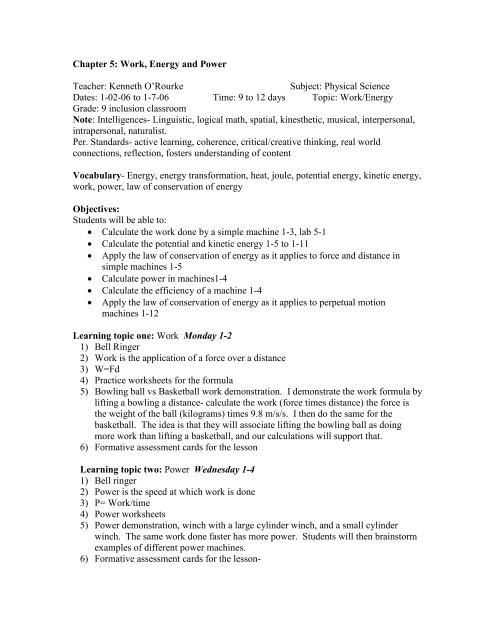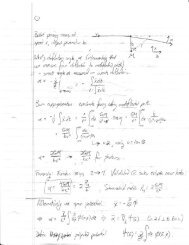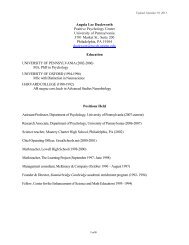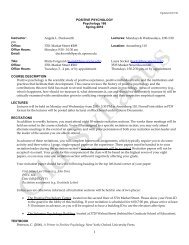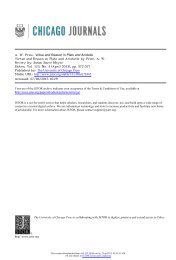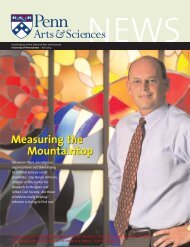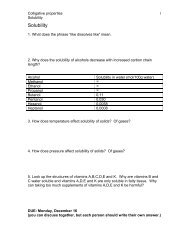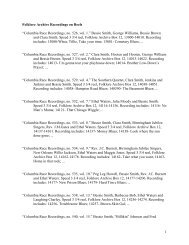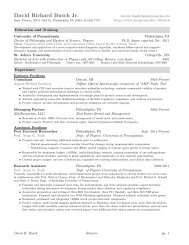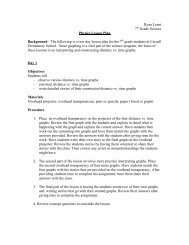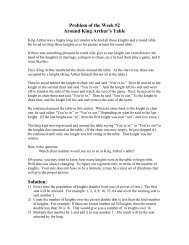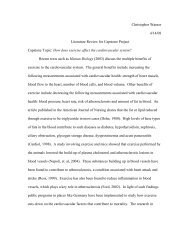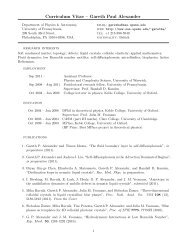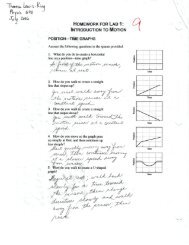Chapter 5: Work, Energy and Power Teacher: Kenneth O'Rourke ...
Chapter 5: Work, Energy and Power Teacher: Kenneth O'Rourke ...
Chapter 5: Work, Energy and Power Teacher: Kenneth O'Rourke ...
Create successful ePaper yourself
Turn your PDF publications into a flip-book with our unique Google optimized e-Paper software.
<strong>Chapter</strong> 5: <strong>Work</strong>, <strong>Energy</strong> <strong>and</strong> <strong>Power</strong><br />
<strong>Teacher</strong>: <strong>Kenneth</strong> O’Rourke<br />
Subject: Physical Science<br />
Dates: 1-02-06 to 1-7-06 Time: 9 to 12 days Topic: <strong>Work</strong>/<strong>Energy</strong><br />
Grade: 9 inclusion classroom<br />
Note: Intelligences- Linguistic, logical math, spatial, kinesthetic, musical, interpersonal,<br />
intrapersonal, naturalist.<br />
Per. St<strong>and</strong>ards- active learning, coherence, critical/creative thinking, real world<br />
connections, reflection, fosters underst<strong>and</strong>ing of content<br />
Vocabulary- <strong>Energy</strong>, energy transformation, heat, joule, potential energy, kinetic energy,<br />
work, power, law of conservation of energy<br />
Objectives:<br />
Students will be able to:<br />
• Calculate the work done by a simple machine 1-3, lab 5-1<br />
• Calculate the potential <strong>and</strong> kinetic energy 1-5 to 1-11<br />
• Apply the law of conservation of energy as it applies to force <strong>and</strong> distance in<br />
simple machines 1-5<br />
• Calculate power in machines1-4<br />
• Calculate the efficiency of a machine 1-4<br />
• Apply the law of conservation of energy as it applies to perpetual motion<br />
machines 1-12<br />
Learning topic one: <strong>Work</strong> Monday 1-2<br />
1) Bell Ringer<br />
2) <strong>Work</strong> is the application of a force over a distance<br />
3) W=Fd<br />
4) Practice worksheets for the formula<br />
5) Bowling ball vs Basketball work demonstration. I demonstrate the work formula by<br />
lifting a bowling a distance- calculate the work (force times distance) the force is<br />
the weight of the ball (kilograms) times 9.8 m/s/s. I then do the same for the<br />
basketball. The idea is that they will associate lifting the bowling ball as doing<br />
more work than lifting a basketball, <strong>and</strong> our calculations will support that.<br />
6) Formative assessment cards for the lesson<br />
Learning topic two: <strong>Power</strong> Wednesday 1-4<br />
1) Bell ringer<br />
2) <strong>Power</strong> is the speed at which work is done<br />
3) P= <strong>Work</strong>/time<br />
4) <strong>Power</strong> worksheets<br />
5) <strong>Power</strong> demonstration, winch with a large cylinder winch, <strong>and</strong> a small cylinder<br />
winch. The same work done faster has more power. Students will then brainstorm<br />
examples of different power machines.<br />
6) Formative assessment cards for the lesson-
Learning topic three: Efficiency Tuesday 1-4<br />
1) Bell Ringer<br />
2) Efficiency of a machine<br />
3) Efficiency= work output/work input<br />
4) <strong>Work</strong>sheets<br />
5) Examples of appliances, their efficiency, <strong>and</strong> why it is important- <strong>and</strong> cheaper.<br />
Student supply examples as well.<br />
7) Formative assessment cards for the lesson- Can a machine’s output ever be more<br />
than its input? If a machine has an input of 50j <strong>and</strong> an output of 45 j, what is its<br />
efficiency? A-110% B-90% C- 0% D- can’t be calculated Can a machine ever<br />
have an efficiency greater than 1?<br />
8) Formative assessment cards for the lesson<br />
Lab 5.1 WORK- Monday 1-3 The students will use a block <strong>and</strong> tackle system to find<br />
out what is sacrificed when you gain a mechanical advantage. It is a 4 question strategy<br />
lab, <strong>and</strong> Monday is the introduction of the lab. We tie the concept of mechanical<br />
advantage with <strong>Work</strong>, <strong>Power</strong>, <strong>and</strong> Efficiency. The students will develop an experiment<br />
to find out if you do less work using a machine. We will develop a hypothesis,<br />
procedures, materials, <strong>and</strong> data table in order to investigate the relationship between<br />
work <strong>and</strong> mechanical advantage.<br />
Learning topic three: <strong>Energy</strong> Wednesday 1-5<br />
1) Bell Ringer<br />
2) <strong>Energy</strong> is the ability to do work<br />
3) Any object that has energy has the ability to create a force<br />
4) Units for energy <strong>and</strong> work are the same, the joule<br />
5) Demonstration of the ability of an objects position being used to do work. The<br />
falling mass raising a lever.<br />
6) Formative assessment cards for the lesson<br />
Learning topic four: Potential <strong>Energy</strong> Wednesday 1-5<br />
1) Bell Ringer<br />
2) Potential energy is stored energy or the energy of position. In other words<br />
gravitational energy. A high object will have more potential energy than an object<br />
of the same mass at a lower height.<br />
3) Formula: Ep= mgh<br />
4) Practicing calculating potential energy<br />
5) Formative assessment cards for the lesson<br />
Learning topic five: Kinetic energy Thursday 1-8
1) Bell Ringer<br />
2) Kinetic energy is the energy of motion. An object moving with a greater velocity<br />
than an object with the same mass will have more energy than the object with a<br />
smaller velocity<br />
3) Formula: Ek= 1/2mv 2<br />
4) Practicing calculating potential energy<br />
5) Formative assessment cards for the lesson<br />
Learning topic six: Conservation of energy 1-9<br />
1) Bell Ringer each day<br />
2) <strong>Energy</strong> cannot be created or destroyed, just transformed from one form into another<br />
3) <strong>Energy</strong> transformations<br />
4) PE to KE Scion Image presentation<br />
5) Potential energy to kinetic energy problems PE1+KE1=PE2+KE2<br />
6) PE to KE worksheets<br />
7) Preview lab 5.2<br />
8) Formative assessment cards for the lesson each day<br />
<strong>Energy</strong> Conservation Lab 5.2, 1-9, 1-10 - By measuring the height, speed, <strong>and</strong> mass of<br />
the marble at different points on the roller coaster, we can calculate the PE <strong>and</strong> KE to<br />
compare to our measured values.<br />
Learning topic seven: 1-11 Other forms of energy<br />
1) Bell Ringer<br />
2) Other forms of energy<br />
3) <strong>Energy</strong> Transformation worksheet<br />
4) Perpetual motion machines<br />
5) Formative assessment cards for the lesson<br />
Home Learning: Vocabulary, worksheets, lab reports, reading<br />
Assessment:<br />
1) Question <strong>and</strong> answer sessions asking students to cite examples<br />
2) <strong>Work</strong>sheets<br />
3) Quizzes<br />
4) MOLP extra help session (one on one evaluation)<br />
5) Formative assessment cards for the lesson each day<br />
6) Bell Ringers<br />
Reflection:


